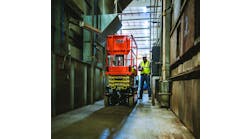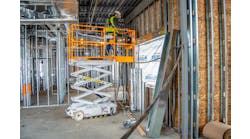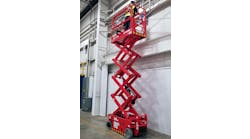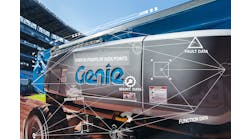THE PARTICIPANTS
- Jay Allen, president, Allen Engineering Corp.
- Scott Grahl, manager of product engineering, concrete, Wacker Neuson
- Bob Motl, director of business development, concrete, Wacker Neuson
- Frank Multerer, president MBW Inc.
- Dawson Westenskow, product manager - corded drilling and demolition tools, Hilti
- Tom Carroll, president, CS Unitec
RER: What are the new technological developments in your company’s equipment in the past year and what do you plan for 2013?
Allen: For rental the big development in 2012 evolving into 2013 was our track buggy. We are coming out with a full track buggy to complement our wheel buggy line, and it’s called the AT16. We pretty much spent all of ‘12 developing the unit and will be launching it in ‘13, at World of Concrete and the ARA show. We’re real excited about it, it’s a two speed, full-track unit, it has a 27-horsepower co-load, hydrostatic transmission and a full 16-foot capacity bucket.
Grahl, Motl: In 2012, Wacker Neuson added the CRT 60, a new 10-foot ride-on trowel, which is the largest in our line. This is the first and only machine in this market segment to use our patented 2-mode electro-hydraulic steering controls providing the operator with two steering response rates. In addition, we’ve added other patent-pending innovations such as the engine power management system. This system functions similarly to an automatic transmission, where as the load increases, the transmission downshifts to keep the engine in an optimal speed range. Also new on the CRT 60 is an integral hydraulic wheel kit that provides several benefits: First, the ability to move the unit on hard surfaces, but more importantly, it allows one operator to change the blades or install pans without the need to use a crane or forklift.
In 2013 we will be introducing a unique machine to the market, the CRT 48-33K-DF model. What makes this unit unique is that it is the first in the industry to offer a dual fuel option. This unit allows the operator to seamlessly change between gasoline and propane while the machine is running. This will be an advantage for rental houses because of jobs where gasoline use is restricted, such as hospital renovations.
Multerer: Our 2012 R&D efforts focused largely on developing a full line of low cost, yet effective single-direction vibratory plates and a diesel-powered, hydraulic-steer 8-foot riding trowel. Our new plate line is patent pending featuring a unique isolation system that significantly lowers cost of production. To remain competitive, U.S. manufacturers must use their ingenuity and expertise to address cost issues that favor nations benefiting from low wages and currency manipulation and suppliers that are little more than copyists.
Westenskow: In 2012 in our demolition line we launched two new wall breakers, the TE 500-AVR and TE 700-AVR. The TE 500-AVR offers a fully decoupled AVR (Active Vibration Reduction) system. The TE 700-AVR utilizes a brushless motor that increases the power of the tool, and eliminates the need for changing brushes.
Also, in the demolition line, we recently launched an updated version of our TE 3000-AVR heavy breaker. The updates were mostly driven by requests from our rental customers, including a detachable cord, along with an updated guide tube and electronics that add 30 to 50 percent more hours between service. The detachable cord, in particular, will reduce downtime by making cord repairs as easy as plugging in a new cord.
In drilling we went back to the drawing board with the TE 60 combi-hammer, increasing the power and torque, and allowing contractors the ability to core in non-reinforced masonry up to four inches in diameter. In cordless also, we launched a new addition to our SDS rotary hammer line. Our new SCM 18-A, a metal-cutting cordless saw, has been well received for its ability to cut rebar, strut channel, and threaded rod with a smooth, fast cut.
Carroll: We introduced several important concrete tool innovations in 2012. We launched our new dust collection vacuum model CS 1435. It has an innovative filter-cleaning system. We also launched a new 7-inch concrete grinder model EBS 180 H with low vibration.
The CS 1435 vacuum is designed for use with all brands of hand-held and walk-behind concrete grinders and other power tools with dust extraction. The key technological advance is the automatic self-cleaning system that cleans the filters while the vacuum continues to work. It is no longer necessary for the operator to stop grinding to clean his filters. The operator continues working while the vacuum collects the concrete dust and cleans itself automatically. This saves valuable time normally lost when the operator must stop grinding to clean the vacuum filters. The CS 1435 has a unique pulse cleaning system that activates when the air pressure drops inside the vacuum. Because this new system incorporates two parallel filters, one filter continues working while the other is shut down and automatically cleaned. The process is then reversed and both filters are cleaned. This allows continuous operation and dust collection. The CS 1435 H comes with HEPA filters. The vacuum has a built-in power outlet for one tool. A two-tool hookup is optional.
Have there been significant new advancements in ergonomics in your company’s equipment and in the industry in general?
Grahl, Motl: Operator comfort is a key factor when designing ride-on trowels. The operator’s station on all joystick-operated trowels has been configured according to a very specific set of dimensions that maximize arm and shoulder comfort. The goal is to provide a machine that the operator can feel comfortable on for an extended period of time (improving productivity) The ride-on trowel market has matured significantly, and the users no longer find it acceptable to stop and stretch or take muscle-relaxing breaks, which was common five to 10 years ago.
Even on manual steer machines, steering efforts have been drastically reduced from the effort required from the operator on older-generation models. There are even added “creature comforts” now such as cup holders and 12-Volt outlets for audio and cell phones. The color of the seat has been changed from black to gray to keep it cooler in direct sunlight.
Walk-behind models also have ergonomic features. Wacker Neuson’s walk-behind models feature a patented dynamically balanced design which reduces forces the operator needs to counteract, providing for nearly effortless operation. Adjustable handle and the pro-shift pitch control (rapid pitch) also improve operator comfort and productivity. Our wet screed utilizes a patent-pending handle design which cuts by half the hand-arm vibration to the operator.
Multerer: MBW addressed ergonomic issues early, from 2000 through about 2006. A number of our products produce the lowest hand/arm vibration levels in the industry. The industry as a whole seems to be making progress on ergonomic issues.
Westenskow: There is no doubt that both ergonomics, and health and safety are important topics in the construction industry. An important part of the ergonomics of a tool is the general guideline of having the right amount of power in a light and compact tool. The TE 700-AVR wall breaker is a great example of this concept in action. We went back to the drawing board and reduced the weight of the previous version, integrated an improved brushless motor, and increased the total power by 20 percent. In addition to the weight and power, the TE 700-AVR also has an innovative AVR (Active Vibration System) that helps to improve user comfort and makes contractors more productive.
Carroll: Ergonomic handling with reduced vibration is the special feature of our new EBS 1809 H, 7-inch concrete grinder. The unique H-shaped handle incorporates shock absorbers to dampen vibration and improve overall handling and direction control. This technology reduces worker fatigue while protecting the worker’s wrists. This ultimately leads to higher productivity and lower costs. The EBS 180 H’s motor is vertically mounted. This allows the air-intake ventilation to be above the floor and dust. This increases reliability and the working life of the armature. The EBS 180 H has an optional cart for a 7-inch walk-behind grinding system. The motor power is 20 amps and the speed is 9500 rpm.
A new product line for 2013 is our Trelawny Surface Preparation Tools. The Trelawny Tools incorporate Vibro-Lo technology in needle scalers, scabblers, piston hammers and deck hammers. These tools are for heavy-duty surface preparation of concrete and steel. The Vibro-Lo technology reduces the risk of vibration-related injuries. This feature allows the operator to prep large surface areas quickly and cleanly. Our Trelawny needle scalers and other tools also incorporate a dust-collection shroud.
How are customers – end users and rental companies – changing and how does that impact what they want in concrete equipment?
Allen: We’re being asked more for low-emissions equipment. We were the first company to launch a propane-powered walk-behind trowel last year, it produces considerably less emissions, and it can be used in closed environments. We’re seeing more requests for that in concrete equipment from both end users and rental companies that are asking, “Can we get this in propane; can we get this in electric?” And we’re trying to develop those products.
In the last four years during the economic downturn, think about how few big boxes were built, such as Lowe’s, Targets, Walmarts, etc. It pretty much stopped. Those retailers want to reformat or reconfigure spacing, so they’ll do store renovations, keeping stores open while they’re sawing concrete, cutting trenches, and pouring new concrete back in. So emissions are a big deal in those types of scenarios. Walmart especially has been a big driver in this. They’re doing a lot of active store renovations right now. So we’re trying to offer low-emissions products and a propane walk-behind is the first of more to come in that area.
Grahl, Motl: Several factors have influenced the direction the market has taken. As the trend continues toward a higher percentage of laser-screeded concrete, contractors are waiting longer to place a trowel on the slab. Due to the inherent flatness of laser screeding, trowelling too early can actually have a negative effect on floor flatness. Therefore, the trend is for machines that are heavier and higher horsepower.
Our exclusive forklift pockets, which provide additional transportation options, also help stiffen the frame allowing the operators to obtain flatter floors. A patent-pending built-in hydraulic wheel kit allows operators to easily raise the machine on the front and back wheels to change the blades or install pans without the need of a forklift or crane, and this allows one person to make the change. Another factor influencing the trowel market is the ‘joystick-generation’ of users. More finishers have a lot of hours operating gaming console joysticks and can therefore adapt quickly to these more user-friendly machines. This phenomenon has also resulted in a greater acceptance of electronics onboard. Ultimately reliability is still the greatest concern and our investments in design engineering, analysis and testing bears this out.
Multerer: Customers want topnotch performance, no maintenance and long life at a lower price rather than comparatively poor performance and high maintenance equipment. The old adage “you get what you pay for” carries less weight when margins are thin, work is scarce, and times uncertain. In such times, what customers want and what they are willing to pay for are often separate questions. The impact is significant. MBW, for example, recently spent considerable time and effort in the development of an economy line of vibratory plates.
Westenskow: Customers at every level are looking for greater productivity from their tools. They want to get the job done more safely and faster, so the ergonomics, safety innovations, and performance of the tools grow in importance. Features such as ATC (Active Torque Control) to provide an additional layer of protection to the operator of a heavy drill against sudden tool body acceleration, AVR (Active Vibration Reduction) to make demolition work easier on the operator, and brushless drives to add to the lifetime of motors all have a significant impact on customer’s choices for the tools they use in the demanding conditions they encounter.
Carroll: More customers and government agencies are demanding cleaner and safer working conditions. This puts pressure on contractors to use safer and more productive but also more expensive technology. With the addition of the Trelawny products CS Unitec is now able to offer a complete package of equipment to the rental industry. Ergonomic power tools, with dust-collection shrouds, coupled with self-cleaning HEPA vacuums are important to the future success of rental stores and their customers. Renting these specialized packages can be cost effective for the contractor and profitable for the store.
How are engine regulations, such as Tier 4, affecting the concrete industry?
Allen: The 2012 EPA requirements with the low permutation tanks, and the fuel canisters, that whole thing with the gasoline engines, had a big impact on our product line and we had to do some redesigns to comply. And then Tier 4 interim and final had a big impact. We were small enough that we were able to take advantage of the flex program, which gives us a little bit more time, but when we go to Tier 4 final on diesel, there will be redesigns, especially for rental.
Grahl, Motl: The most visible difference is in the cost. Even on a 35-to-45 hp machine, the Tier IV diesel engine will add several thousand dollars to the cost of the machine. As horsepower climbs, so does the cost. However, the market will also begin to see some of the advantages of the technologies used in this new generation of engines. The transition to cooled exhaust gas recirculation, electronic high-pressure common-rail fuel injection, and charge-air cooling has had some tangible benefits. Here are a few examples that are both practical and environmentally friendly:
a. Higher horsepower from smaller displacements means better fuel efficiency.
b. Significantly longer oil change intervals: In some cases what used to be 150 hour oil change interval is now 500 hours.
c. As diesels inherently produce very low carbon monoxide levels relative to gasoline or propane engines, the reduction in particulates and other exhaust compounds means these machines may be able to be used for longer periods in applications with less ventilation, such as tunnels and renovations.
As a result of the cost increases in the diesel market, we see a sector of the market transitioning back to gasoline engines. Just as in the automotive market, advances in gasoline engine fuel efficiency and new engine offerings will give an edge over diesel in some applications.
Multerer: Tier 4’s primary effect has been on engine manufacturers and the manufacturers of fuel system components. In some cases the cost of compliance has been too great for older engine models, which have been discontinued. There will be some elevated costs associated with compliance, but beyond that, not much real affect on the concrete industry. There may be some compliance issues in connection with the sale of used machinery.
How are advanced electronics systems affecting concrete equipment?
Grahl, Motl: Wacker Neuson has several examples of electronics-based features in production today, such as the following:
a. Our exclusive patented Gyro sensor safety shutdown system on our walk-behind trowels provides an added level of security to the user by significantly reducing a runaway handle situation
b. Patented two-mode steering system allows operators to select the response of the joysticks to meet their preference and best suit the concrete conditions. This can also make it easier for new operator/finishers to get comfortable with the machine.
c. The use of an electronic blade speed control foot pedal allows the adoption of the next 2 features:
d. Patent-pending engine power regulation system (as mentioned above) constantly monitors engine speed and adjusts hydraulic load, allowing the unit to seamlessly run at optimal engine and blade speed for maximum power input to the concrete.
e. Exclusive electronic cruise control provides a consistent speed and is easily set by holding the pedal at the required speed and tapping the button.
These technologies are allowing us to evolve into the next level of machines to be launched in 2013 and 2014. These systems will integrate some of the technologies previously seen, such as having a Tier IV diesel engine controller communicating on-board with the hydraulic drive and steering systems to optimize performance.
Last year a few manufacturers said the recession led to significant decreases in R&D expenditure. Is this still an issue for your company?
Allen: We’re family owned so we don’t necessarily have shareholders to contend with, so we were able to continue and actually increase R&D expenditure over the last four years during the recession because we thought it was a strategic opportunity to really expand our product line. We’ve made significant advances in our product line in the last four years, although a lot was not rental related. We moved aggressively into the heavy paving market, expanded our walk-behind trowel offering, we bought another power buggy, and got into the power-buggy business and now we’re expanding that product offering as well.
Grahl, Motl: Most manufacturers were forced, in the 2009 business climate, to ‘trim the fat’ from their development projects. Wacker Neuson saw this as an opportunity to position ourselves for the returning market demand. We are now launching products that were under development during the 2007-2011 timeframe and those product launch plans have been maintained.
Multerer: As a percentage of sales, our R&D expenditures are significantly above historical norms. That said, our sales are still somewhat below their 2007 peak. I could do a pretty good job of spinning this answer but the truth is that peak to present, R&D expenditures are still down somewhat. I would speculate that the industry as a whole is in similar territory.
Hilti: At Hilti, we continue to place a high premium on innovation. Part of that commitment is that throughout this economic downturn we have continued to invest heavily in innovation and the development of new technologies. We will continue this commitment to R&D into 2013.
Carroll: Our business has grown during the recession. The need for our innovative equipment on infrastructure jobs and in heavy industry has allowed us to continue to invest in R&D, new technologies and new products.
Any thoughts on the economic climate in the year to come?
Allen: We’re cautiously optimistic. We had a fairly strong fourth quarter for our business so far, when it typically slows down and it hasn’t. It has slowed down seasonally but it’s been much stronger than the last couple of years, and we’re seeing a fair amount of optimism with our dealers and our rental centers as well as our contractor customers, so they are getting work and hoping to make some capital equipment purchases. All things being equal, obviously a major event like a fiscal cliff or an economic meltdown because of that would obviously change everything but if the political environment doesn’t have a major impact on the economic environment, I think we’ll be fine next year. If the guys in Washington don’t do something stupid, I think we’ll be alright.
Grahl, Motl: We see continued cautious growth. Some areas of the world will continue to lag while others will grow more rapidly. Overall, we see steadily increasing construction spending and cement consumption. However, value will still be the driving decision factor for the customer.
Multerer: My sense is that the economic climate is gradually warming. But there’s still a lot of uncertainty out there and a number of fundamental fiscal issues that need attention. Tough question to answer right now.
Hilti: You can read the newspapers and get one story, but talk to our customers and you see another. Our customers are optimistic about the future and so are we. We expect strong growth in 2013.
Carroll: Probably there will be a mild recession in 2013. Regardless of the fiscal cliff issues I believe there will be good opportunities to grow in the current and future economic climate of 2013.
Any other points you’d like to add?
Allen: We’re family owned and we’re American made, that’s kind of our unique approach to the market, and we think it resonates well with both independent rental centers and dealers, they like that. We try to add that kind of family touch to our customers and the way we do business.





